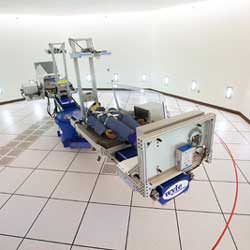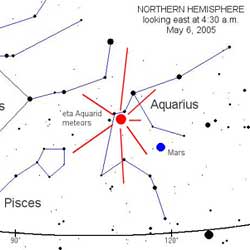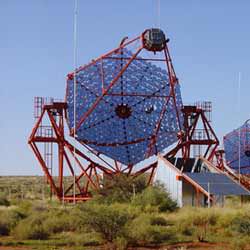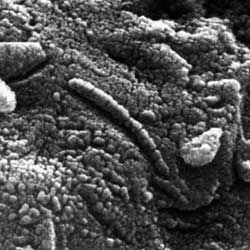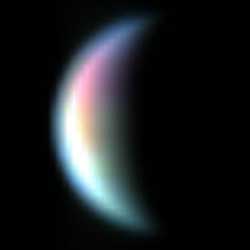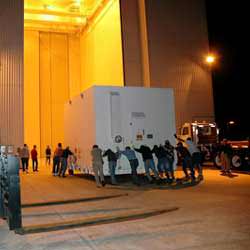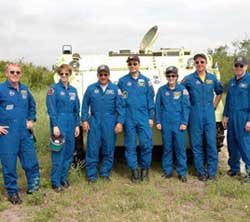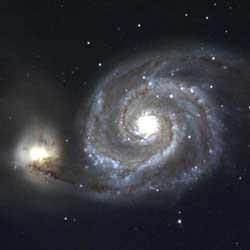
Galaxy M51. Image credit: Todd Boroson/NOAO/AURA/NSF. Click to enlarge.
Monday, May 2 – If you’re up before dawn today, look closely at the Moon – ruddy Mars will make its appearance less than 3 degrees north of its waning form.
With early evening dark skies, this would be an excellent time for mid-sized binoculars and telescope users to discover anew the fantastic “Whirlpool Galaxy”. Designated as NGC 5194, this impressive face-on spiral galaxy was discovered by Charles Messier in October of 1773 and cataloged as the M51. You can find it easily by heading about three finger-widths southwest of Eta Ursa Majoris (the end star in the handle of “the Big Dipper”) and in the same finderscope of binocular field as faint star 24 Canes Venaticorum.
At around 35 million light years away, the “Whirlpool” is a spiral delight to all optical aid. Binoculars at a dark location will see it as a large, round “haze” with a brightness toward the center. Small scopes will reveal its galactic nature and satellite galaxy, NGC 5195. With large aperture, this galaxy comes alive with detail. 10″ will clearly show spiral arm structure, while at 12.5″ knots, clusters, stellar condensations and dark dustlanes become wonderfully apparent – making the M51 one of the very few deep space objects that look like a photograph in the eyepiece. Absolutely one of the finest in the night sky!
Tuesday, May 3 – During the very early morning hours, take the opportunity that darker skies provide and view the Alpha Scorpiid meteor shower during its peak. The radiant is near Antares. Later in the morning, try using binoculars to locate Uranus as it appears a little more than three degrees north of the Moon.
Tonight’s destination is a very compact and bright little galaxy that can be seen in larger binoculars and is an easy telescope target – M94. Start by identifying past study Cor Caroli (Alpha Canum). About half a fist width to its northwest you will see Beta. Aim your scopes or binocular mid-way between the two and move slightly more than a degree towards the last star in the handle of the Big Dipper – Alkaid. The M94 was discovered in 1781 by my hero, Mechain, and this small galaxy has a powerful central core. At around 20 million light years away, smaller scopes will have difficulty resolving detail, but larger apertures under ideal conditions will pick up on its tightly-wound spiral structure.
Wednesday, May 4 – If you missed your chance to catch a “shooting star” yesterday morning, then why not try again today as the Eta Aquarids reach their peak? With a fall rate of about 21 per hour, this highly dependable annual shower is the offspring of Comet Halley. With far less Moon to interfere, these bright yellow meteors with outstanding trails are well worth looking for. If skies are cloudy, don’t worry. The Eta Aquarid stream stays active for another week.
Tonight let’s further our understanding of distance and how it effects what we see. As you know, light travels at an amazing speed of about 300,000 kilometers per second. To get a grasp on this concept, how many seconds are there in a minute? An hour? A week? A month? How about a year? Ah, you’re beginning to see the light! For every second – 300,000 kilometers. Now, go back to previous study M3 located between Arcturus and Cor Caroli. This great globular cluster is about 40,000 light years away. In terms of kilometers – that’s far more zeros than most of us can possibly understand – yet we can still see this great globular cluster.
Now let’s locate M53. Roughly halfway between Arcturus and Denebola is faint star Alpha Comae. Aim your binoculars or telescopes there and you will find the M53 about a degree northeast. This very rich, magnitude 8.7 globular cluster is almost identical to the M3, but look at what a difference an additional 25,000 light years can make to how we see it! Larger telescopes will enjoy the compact bright core as well as resolution at the cluster’s outer edges. As a bonus for scopes, look one degree to the southeast for peculiar round cluster NGC 5053. Classed as a very loose globular, this magnitude 10.5 grouping is one of the least luminous objects of its type due to low stellar population and wide separation of members – yet its distance is almost the same.
Thursday, May 5 – Today in 1961, astronaut Alan Shepard made history as he became the first American in “space”. Onboard the Mercury craft, Freedom 7, Shephard spent 15 minutes in a sub-orbital ride of a lifetime. By today’s standards this is considered “shallow space”, but your chance to view something far more distant and every bit as history making is now here.
If you did not get an opportunity to view Comet 9/P Tempel 1 last week, then try again as it will be about two degrees west/southwest of Epsilon Virginis. Projected magnitudes show that Tempel 1 should be around magnitude 10 at this time and recent observing reports indicate that it is condensing well and will be easily distinguishable as cometary. In two months time, the “Deep Impact” mission will have reached Tempel 1 and the result of its experimentation may make the comet flare brightly enough to be seen with the unaided eye. Stay tuned!
Friday, May 6 – Looking for your chance to spot Mercury? Then let the Moon be your guide as the two will appear just before dawn. The swift inner planet will appear about 3 degrees south of the slender crescent Moon for most observers.
Tonight let’s have a little bit of fun. For binocular users, we’re going to visit a large star cluster and a small galaxy. Our beginning destination is Melotte 111, a large hazy patch of stars visible to the unaided eye in Coma Berenices. Known as the “Queen’s Hair”, this five degree span of 5th to 10th magnitude stars is wonderfully rich and colorful. As legend has it, Queen Berenices offered her beautiful long tresses to the gods for the King’s safe return from battle. Touched by her love, the god’s took Berenices’ sacrifice and immortalized it in the stars.
While our next destination isn’t quite so romantic, I think you’ll enjoy getting a “Blackeye”. Located 1 degree east/northeast of 35 Comae, this small bright galaxy can be caught in the same wide binocular field northwest of previous study – M53. Originally discovered by Bode about a year before Messier cataloged it, the M64 is about 25 million light years away and holds the distinction of being one of the more massive and luminous of spiral galaxies. Telescope users will find this particular galaxy most endearing for its namesake – a very wide dark dustlane to the northeast side of the galaxy’s bright core. Power up and enjoy this very unusual treasure!
Saturday, May 7 – Tonight at at about 11:03 p.m. PDT for western United States observers in a rough line between Sacramento to Barstow and San Diego, CA (including Yuma, AZ and northern Mexico), a unique opportunity arrives to help contribute to science. A magnitude 11.7 star is being occulted by a large, and possible binary asteroid named Ophelia. According to Dr. Raoul Behrend of Geneva Observatory, “The recent lightcurve of asteroid (171) Ophelia, shows strong similarities with other binary asteroids.” While the dual nature of this asteroid is still being debated, only radar and observations during an occultation can help to help confirm it, and a single-body theory is not ruled out. “We are working on the interpretation of the lightcurve using various models:
– a single body – a pear which can reproduce the lightcurve, but with departure which seem to be significative – a single body with a huge crater (like Mathilde) – which seems to be ruled out, and
– two bodies – the most difficult to model, but preliminary results are nice. So, as we can’t exclude the single body (at 2/3 level), our preference goes actually to the binary system.” The work with Ophelia’s light curve continues further in this working document which explores sizes in the event of binarity. In a call to observers, Dr. Behrend says, “Good occultations by Ophelia are extremely rare; the last one for *many years* is around 2005-05-08 at 6h UT, over California, Arizona, and Mexico”. If Ophelia should prove to be a binary asteroid, the resulting separation would be near a maximum as predicted by Behrend’s lightcurve. “Every positive, every negative observation is important to determine the binarity state (yes or no), and the size(s). If binarity if confirmed, then the mass, scale, density, albedo and other important physical parameters could be determined with an impressive precision.”
For further information on this event, view the prediction by Steve Preston. If you are in the path of the occultation and wish further information on how to view, record and time the event, please contact Derek Breit or access this page for further instructions.
For the rest of us, we can still have lots of fun viewing another asteroid. In a matter of hours, Ceres will reach opposition and an admirable magnitude of 7. You can spot it easily tonight just northwest (and in the same binocular field) as Beta Librae. Best of luck!
Sunday, May 8 – Tonight is New Moon and time to dish you up a very special galactic treat. Located just a little less than two degrees east of 17 Comae, the NGC 4565 is one of the largest and most beautiful of edge-on galaxies. For the small telescope, it will appear as a very thin scratch of light. As aperture progresses, so does the view. With mid-sized scopes, this impressive galaxy becomes a bright, needle-like silver scratch with a small, almost stellar nucleus. For larger scopes and the trained eye, you will see perfect edge-on form with a dark dissecting dustlane. This is one extremely fine galaxy… Enjoy!
Until next week? May all your journeys be at Light Speed! ….~Tammy Plotner
